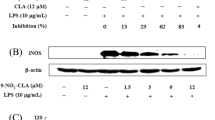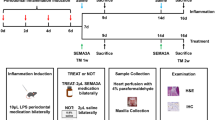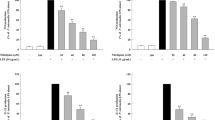Abstract
Macrophages show two main phenotypes, the M1-type (pro-inflammatory) and the M2-type (anti-inflammatory). The purpose of this research was to investigate the regulatory effect of carbon monoxide releasing molecule-3 (CORM-3) on LPS-induced macrophage polarization. LPS-induced RAW264.7 cells were exposed to CORM-3 for 24 h. Polarization of cells was checked by flow cytometry; expression of M1 or M2 macrophage-related factors and NF-κB signaling factors was examined by RT-PCR, ELISA, and Western blot. Male C57 mice were divided into three groups: normal group; periodontitis group, where experimental periodontitis was established in mice; LPS+CORM-3 group, where mice with experimental periodontitis were treated with CORM-3. Polarization of macrophages and the expression of M1 or M2 macrophage-related factors were detected by immunofluorescence, ELISA, and RT-PCR. CORM-3 significantly reduced M1 macrophage proportion, but increased M2 proportion in LPS-stimulated cells. Accordingly, CORM-3 significantly suppressed the expression of M1 macrophage-related TNF-α, iNOS, IL-1β, and IL-6, but promoted M2-related IL-10 and Arg-1. The expression of p-p65, p-p50, and p-IκB induced with LPS was inhibited by CORM-3. In vivo experiments indicated that CORM-3 induced more M2 macrophages in periodontal tissues in mice with experimental periodontitis. The expression of M1 macrophage-related factor in periodontitis was inhibited, but the expression of M2-related factors was increased by CORM-3. CORM-3 inhibits macrophage polarization to pro-inflammatory M1-type and promotes to anti-inflammatory M2-type, which provides scientific basis for the application of CORM-3 in the treatment of periodontitis.






Similar content being viewed by others
Availability of Data and Material
The data used to support the findings of this study are available from the corresponding author upon request.
References
Listgarten, M.A. 1986. Pathogenesis of periodontitis. Journal of Clinical Periodontology 13 (5): 418–430.
Belting, C.M., M. Massler, and I. Schour. 1953. Prevalence and incidence of alveolar bone disease in men. Journal of the American Dental Association (1939) 47 (2): 190–197.
Lv, R., Q. Bao, and Y. Li. 2017. Regulation of M1type and M2type macrophage polarization in RAW264.7 cells by Galectin9. Molecular Medicine Reports 16 (6): 9111–9119.
He, L., and A.G. Marneros. 2014. Doxycycline inhibits polarization of macrophages to the proangiogenic M2-type and subsequent neovascularization. The Journal of Biological Chemistry 289 (12): 8019–8028.
Gordon, S., and F.O. Martinez. 2010. Alternative activation of macrophages: mechanism and functions. Immunity 32 (5): 593–604.
Mantovani, A., A. Sica, and M. Locati. 2007. New vistas on macrophage differentiation and activation. European Journal of Immunology 37 (1): 14–16.
Dos Anjos Cassado, A. 2017. F4/80 as a major macrophage marker: the case of the peritoneum and spleen. Results and Problems in Cell Differentiation 62: 161–179.
Sawle, P., R. Foresti, B.E. Mann, T.R. Johnson, C.J. Green, and R. Motterlini. 2005. Carbon monoxide-releasing molecules (CO-RMs) attenuate the inflammatory response elicited by lipopolysaccharide in RAW264.7 murine macrophages. British Journal of Pharmacology 145 (6): 800–810.
Song, H., H. Zhao, Y. Qu, Q. Sun, F. Zhang, Z. Du, W. Liang, Y. Qi, and P. Yang. 2011. Carbon monoxide releasing molecule-3 inhibits concurrent tumor necrosis factor-alpha- and interleukin-1beta-induced expression of adhesion molecules on human gingival fibroblasts. Journal of Periodontal Research 46 (1): 48–57.
Pan, Y., J. Song, L. Ma, X. Zong, H. Chen, B. Zhao, Q. Yu, and H. Song. 2018. Carbon monoxide releasing molecule 3 inhibits osteoclastogenic differentiation of RAW264.7 cells by heme oxygenase-1. Cellular Physiology and Biochemistry 50 (5): 1988–2003.
Murakami, A., T. Shigemori, and H. Ohigashi. 2005. Zingiberaceous and citrus constituents, 1'-acetoxychavicol acetate, zerumbone, auraptene, and nobiletin, suppress lipopolysaccharide-induced cyclooxygenase-2 expression in RAW264.7 murine macrophages through different modes of action. The Journal of Nutrition 135 (12 Suppl): 2987S–2992S.
Kunimasa, K., M. Ikekita, M. Sato, T. Ohta, Y. Yamori, M. Ikeda, S. Kuranuki, and T. Oikawa. 2010. Nobiletin, a citrus polymethoxyflavonoid, suppresses multiple angiogenesis-related endothelial cell functions and angiogenesis in vivo. Cancer Science 101 (11): 2462–2469.
Conti, G., S. Tambalo, G. Villetti, S. Catinella, C. Carnini, F. Bassani, N. Sonato, A. Sbarbati, and P. Marzola. 2010. Evaluation of lung inflammation induced by intratracheal administration of LPS in mice: comparison between MRI and histology. MAGMA 23 (2): 93–101.
Baker, R.G., M.S. Hayden, and S. Ghosh. 2011. NF-kappaB, inflammation, and metabolic disease. Cell Metabolism 13 (1): 11–22.
Baumgartl, J., S. Baudler, M. Scherner, V. Babaev, L. Makowski, J. Suttles, M. McDuffie, K. Tobe, T. Kadowaki, S. Fazio, C.R. Kahn, G.S. Hotamisligil, W. Krone, M. Linton, and J.C. Brüning. 2006. Myeloid lineage cell-restricted insulin resistance protects apolipoproteinE-deficient mice against atherosclerosis. Cell Metabolism 3 (4): 247–256.
Chen, S., Z. Lu, F. Wang, and Y. Wang. 2018. Cathelicidin-WA polarizes E. coli K88-induced M1 macrophage to M2-like macrophage in RAW264.7 cells. International Immunopharmacology 54: 52–59.
Martinez, F.O., and S. Gordon. 2014. The M1 and M2 paradigm of macrophage activation: time for reassessment. F1000Prime Reports 6: 13.
Motterlini, R., J.E. Clark, R. Foresti, P. Sarathchandra, B.E. Mann, and C.J. Green. 2002. Carbon monoxide-releasing molecules: characterization of biochemical and vascular activities. Circulation Research 90 (2): E17–E24.
Otterbein, L.E., F.H. Bach, J. Alam, M. Soares, H. Tao Lu, M. Wysk, R.J. Davis, R.A. Flavell, and A.M. Choi. 2000. Carbon monoxide has anti-inflammatory effects involving the mitogen-activated protein kinase pathway. Nature Medicine 6 (4): 422–428.
Sethi, J.M., L.E. Otterbein, and A.M. Choi. 2002. Differential modulation by exogenous carbon monoxide of TNF-alpha stimulated mitogen-activated protein kinases in rat pulmonary artery endothelial cells. Antioxidants & Redox Signaling 4 (2): 241–248.
Cepinskas, G., K. Katada, A. Bihari, and R.F. Potter. 2008. Carbon monoxide liberated from carbon monoxide-releasing molecule CORM-2 attenuates inflammation in the liver of septic mice. American Journal of Physiology. Gastrointestinal and Liver Physiology 294 (1): G184–G191.
Chlopicki, S., R. Olszanecki, E. Marcinkiewicz, M. Lomnicka, and R. Motterlini. 2006. Carbon monoxide released by CORM-3 inhibits human platelets by a mechanism independent of soluble guanylate cyclase. Cardiovascular Research 71 (2): 393–401.
Ferrandiz, M.L., N. Maicas, I. Garcia-Arnandis, M.C. Terencio, R. Motterlini, I. Devesa, L.A. Joosten, W.B. van den Berg, and M.J. Alcaraz. 2008. Treatment with a CO-releasing molecule (CORM-3) reduces joint inflammation and erosion in murine collagen-induced arthritis. Annals of the Rheumatic Diseases 67 (9): 1211–1217.
Foresti, R., J. Hammad, J.E. Clark, T.R. Johnson, B.E. Mann, A. Friebe, C.J. Green, and R. Motterlini. 2004. Vasoactive properties of CORM-3, a novel water-soluble carbon monoxide-releasing molecule. British Journal of Pharmacology 142 (3): 453–460.
Ulbrich, F., K.B. Kaufmann, A. Meske, W.A. Lagreze, M. Augustynik, H. Buerkle, C.C. Ramao, J. Biermann, and U. Goebel. 2016. The CORM ALF-186 mediates anti-apoptotic signaling via an activation of the p38 MAPK after ischemia and reperfusion injury in retinal ganglion cells. PLoS One 11 (10): e0165182.
Ren, J., L. Li, Y. Wang, J. Zhai, G. Chen, and K. Hu. 2019. Gambogic acid induces heme oxygenase-1 through Nrf2 signaling pathway and inhibits NF-kappaB and MAPK activation to reduce inflammation in LPS-activated RAW264.7 cells. Biomedicine & Pharmacotherapy 109: 555–562.
Wang, C.Y., M.W. Mayo, and A.S. Baldwin Jr. 1996. TNF- and cancer therapy-induced apoptosis: potentiation by inhibition of NF-kappaB. Science 274 (5288): 784–787.
Sen, R., and D. Baltimore. 1986. Inducibility of kappa immunoglobulin enhancer-binding protein Nf-kappa B by a posttranslational mechanism. Cell 47 (6): 921–928.
Mosser, D.M., and J.P. Edwards. 2008. Exploring the full spectrum of macrophage activation. Nature Reviews. Immunology 8 (12): 958–969.
Italiani, P., and D. Boraschi. 2014. From monocytes to M1/M2 macrophages: phenotypical vs. functional differentiation. Frontiers in Immunology 5: 514.
Biswas, S.K., M. Chittezhath, I.N. Shalova, and J.Y. Lim. 2012. Macrophage polarization and plasticity in health and disease. Immunologic Research 53 (1-3): 11–24.
Gonzalez, O.A., M.J. Novak, S. Kirakodu, A. Stromberg, R. Nagarajan, C.B. Huang, K.C. Chen, L. Orraca, J. Martinez-Gonzalez, and J.L. Ebersole. 2015. Differential gene expression profiles reflecting macrophage polarization in aging and periodontitis gingival tissues. Immunological Investigations 44 (7): 643–664.
Huang, Y., T. Ma, Z. Ye, H. Li, Y. Zhao, W. Chen, Y. Fu, Z. Ye, A. Sun, and Z. Li. 2018. Carbon monoxide (CO) inhibits hydrogen peroxide (H2O2)-induced oxidative stress and the activation of NF-kappaB signaling in lens epithelial cells. Experimental Eye Research 166: 29–39.
Funding
This work was supported by Shandong Provincial Natural Science Foundation (grant number [ZR2020MH186]), Jinan Science and Technology Innovation Program in Clinical Medicine (grant numbers [201805045]), and Shandong Provincial Science and Technology Development Plan (grant number [2010GSF10270]).
Author information
Authors and Affiliations
Contributions
All authors contributed to the study conception and design. Material preparation, data collection, and analysis were performed by Tingting Liu; Qingbin Han and Yan Pan participated in the in vivo procedures. The first draft of the manuscript was written by Tingting Liu; Jingyuan Li and Hui Song have been involved in analyzing the data and revising the manuscript critically. All authors commented on previous versions of the manuscript. All authors read and approved the final manuscript.
Corresponding author
Ethics declarations
Ethics Approval and Consent to Participate
Approval was obtained from the ethics committee of Shandong University School of Stomatology. The procedures used in this study adhere to the tenets of the Declaration of Helsinki.
Consent to participate: not applicable.
Consent for Publication
Not applicable.
Conflict of Interest
The authors declare no competing interests.
Additional information
Publisher’s Note
Springer Nature remains neutral with regard to jurisdictional claims in published maps and institutional affiliations.
Supplementary Information
ESM 1
(PDF 242 kb)
Rights and permissions
About this article
Cite this article
Liu, T., Han, Q., Pan, Y. et al. Carbon Monoxide-Releasing Molecule-3 Regulates the Polarization of Lipopolysaccharide-Induced Macrophages. Inflammation 44, 1737–1749 (2021). https://doi.org/10.1007/s10753-021-01450-x
Received:
Revised:
Accepted:
Published:
Issue Date:
DOI: https://doi.org/10.1007/s10753-021-01450-x




